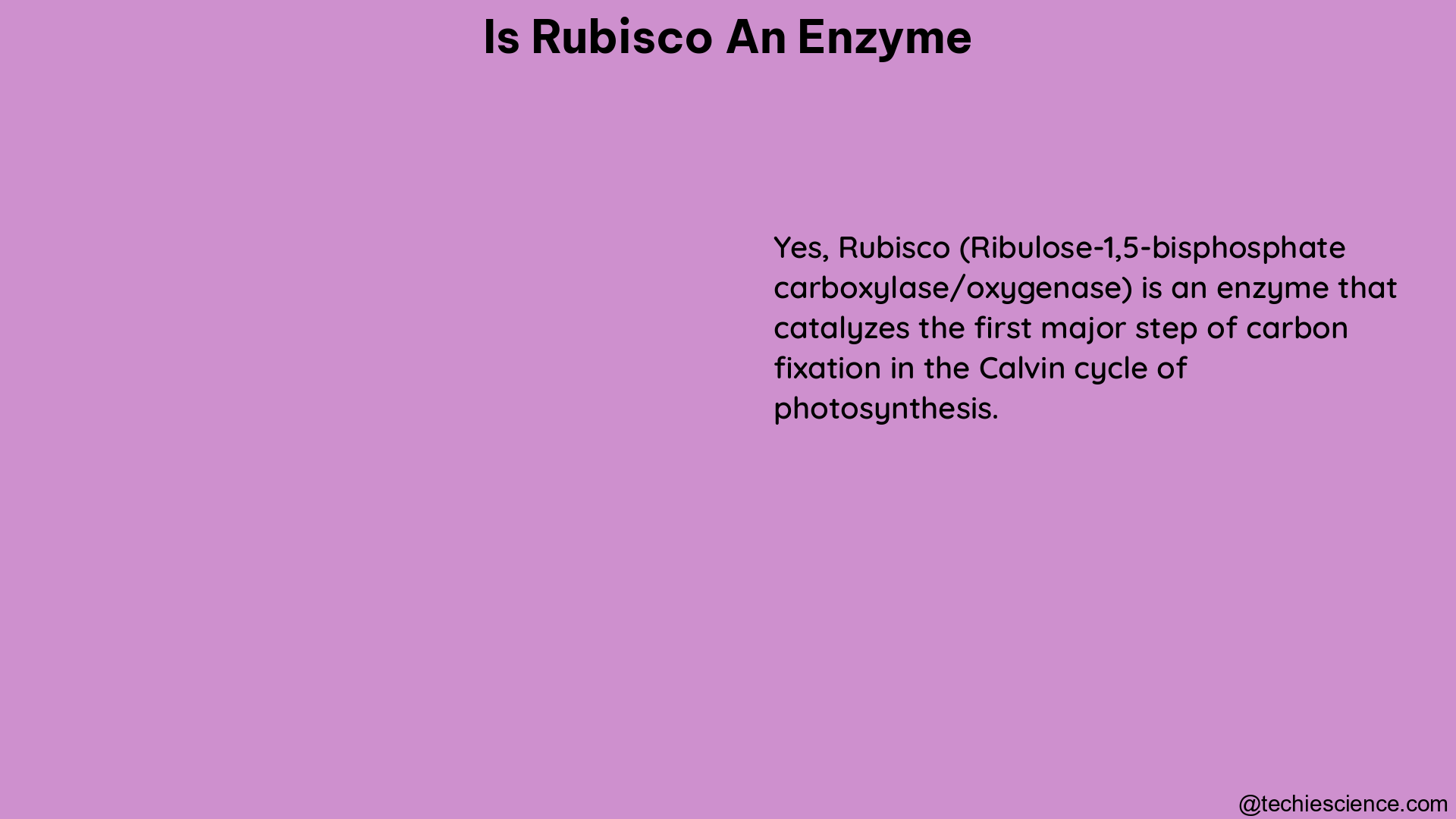Rubisco (Ribulose-1,5-bisphosphate carboxylase/oxygenase) is a crucial enzyme that plays a vital role in the process of photosynthesis, which is the foundation for the biosphere’s productivity. This enzyme catalyzes the addition of carbon dioxide (CO2) to ribulose-1,5-bisphosphate (RuBP), a critical step in the Calvin-Benson cycle, where plants, algae, and some bacteria convert CO2 into organic compounds.
The Structure and Composition of Rubisco
Rubisco is a large enzyme, with a molecular weight of approximately 550 kilodaltons (kDa). It consists of at least two types of subunits: the large subunits and the small subunits. The large subunits are responsible for the enzyme’s catalytic activity, while the small subunits are believed to play a regulatory role.
The large subunits of Rubisco are encoded by the rbcL gene, which is located in the chloroplast genome of plants and algae. The small subunits are encoded by the rbcS gene, which is located in the nuclear genome. The assembly of the Rubisco holoenzyme involves the coordinated expression and import of both the large and small subunits into the chloroplast.
Rubisco’s Catalytic Activity

Rubisco’s primary function is to catalyze the addition of CO2 to RuBP, which is the first step in the Calvin-Benson cycle. This reaction produces two molecules of 3-phosphoglycerate (3-PGA), which are then used to synthesize various organic compounds, such as glucose, lipids, and amino acids.
The catalytic activity of Rubisco can be measured in several ways, including:
-
Carboxylase Activity: The carboxylase activity of Rubisco can be expressed as the amount of CO2 incorporated per minute per milligram of protein (μmol CO2 incorporated min−1 mg−1 protein). This can be determined from the stoichiometric production of two molecules of 3-PGA per molecule of CO2 fixed.
-
Turnover Number (kcat): The turnover number, or kcat, is the number of substrate molecules converted to product per enzyme molecule per second (s−1). This parameter provides a measure of the catalytic efficiency of Rubisco.
-
Specific Activity: The specific activity of Rubisco can be determined by measuring the rate of 3-PGA production, which can be continuously monitored by the decrease in absorbance at 340 nm due to the oxidation of NADH.
Factors Affecting Rubisco’s Activity
Rubisco’s activity can be influenced by various environmental and physiological factors, including:
-
Temperature: Rubisco’s activity generally increases with higher temperatures, but this can also lead to an increased rate of photorespiration, which can reduce the overall efficiency of photosynthesis.
-
Light Intensity: The availability of light can affect Rubisco’s activity, as it is involved in the light-dependent reactions of photosynthesis.
-
CO2 and O2 Concentrations: The concentrations of CO2 and O2 can impact Rubisco’s carboxylase and oxygenase activities, respectively. Higher CO2 levels can enhance Rubisco’s carboxylase activity, while higher O2 levels can promote its oxygenase activity, leading to photorespiration.
-
Rubisco Activase: This enzyme is responsible for activating Rubisco by removing inhibitory sugar phosphates from the active site, allowing the enzyme to bind CO2 and RuBP effectively.
-
Post-translational Modifications: Rubisco’s activity can be regulated by various post-translational modifications, such as carbamylation, phosphorylation, and redox-dependent changes, which can affect its catalytic efficiency and interactions with other proteins.
Importance of Rubisco in Photosynthesis and Agriculture
Rubisco is a vital enzyme for photosynthesis, as it catalyzes the first step in the Calvin-Benson cycle, which is the primary pathway for carbon fixation in plants, algae, and some bacteria. This makes Rubisco one of the most abundant proteins on Earth, with estimates suggesting that it accounts for up to 50% of the total soluble protein in plant leaves.
However, Rubisco has a relatively low catalytic rate, which is one of the reasons why photosynthesis is not more efficient. This has led to ongoing research efforts to improve Rubisco’s catalytic properties, either through genetic engineering or by exploring alternative carbon-fixing enzymes from other organisms.
Understanding Rubisco’s kinetics, regulation, and the factors that influence its activity is crucial for improving photosynthetic efficiency and increasing agricultural productivity. This knowledge can be applied to develop strategies for enhancing crop yields, improving biofuel production, and mitigating the effects of climate change on global food security.
Conclusion
In summary, Rubisco is a crucial enzyme that plays a central role in the process of photosynthesis, catalyzing the addition of CO2 to RuBP, a critical step in the Calvin-Benson cycle. Its structure, catalytic activity, and regulation by various factors have been extensively studied, and this knowledge is essential for advancing our understanding of photosynthesis and its applications in agriculture and biotechnology.
References
- Insights into the Structure of Rubisco from Dinoflagellates-In Silico Modelling of the Symbiodinium sp. Enzyme. https://www.ncbi.nlm.nih.gov/pmc/articles/PMC8395205/
- Plant Science 131 Part 2 Flashcards. https://quizlet.com/777086027/plant-science-131-part-2-flash-cards/
- A non-radioactive method for measuring Rubisco activase activity in Nicotiana tabacum L. https://www.ncbi.nlm.nih.gov/pmc/articles/PMC3923112/
- Determining RuBisCO activation kinetics and other rate and regulation parameters from limited experimental data. https://academic.oup.com/jxb/article/57/14/3883/587191
- Ribulose-1,5-bisphosphate. https://www.sciencedirect.com/topics/agricultural-and-biological-sciences/ribulose-1-5-bisphosphate
Hi….I am Ganeshprasad DN, completed my Ph.D. in Biochemistry from Mangalore University, I intend to use my knowledge and technical skills to further pursue research in my chosen field.